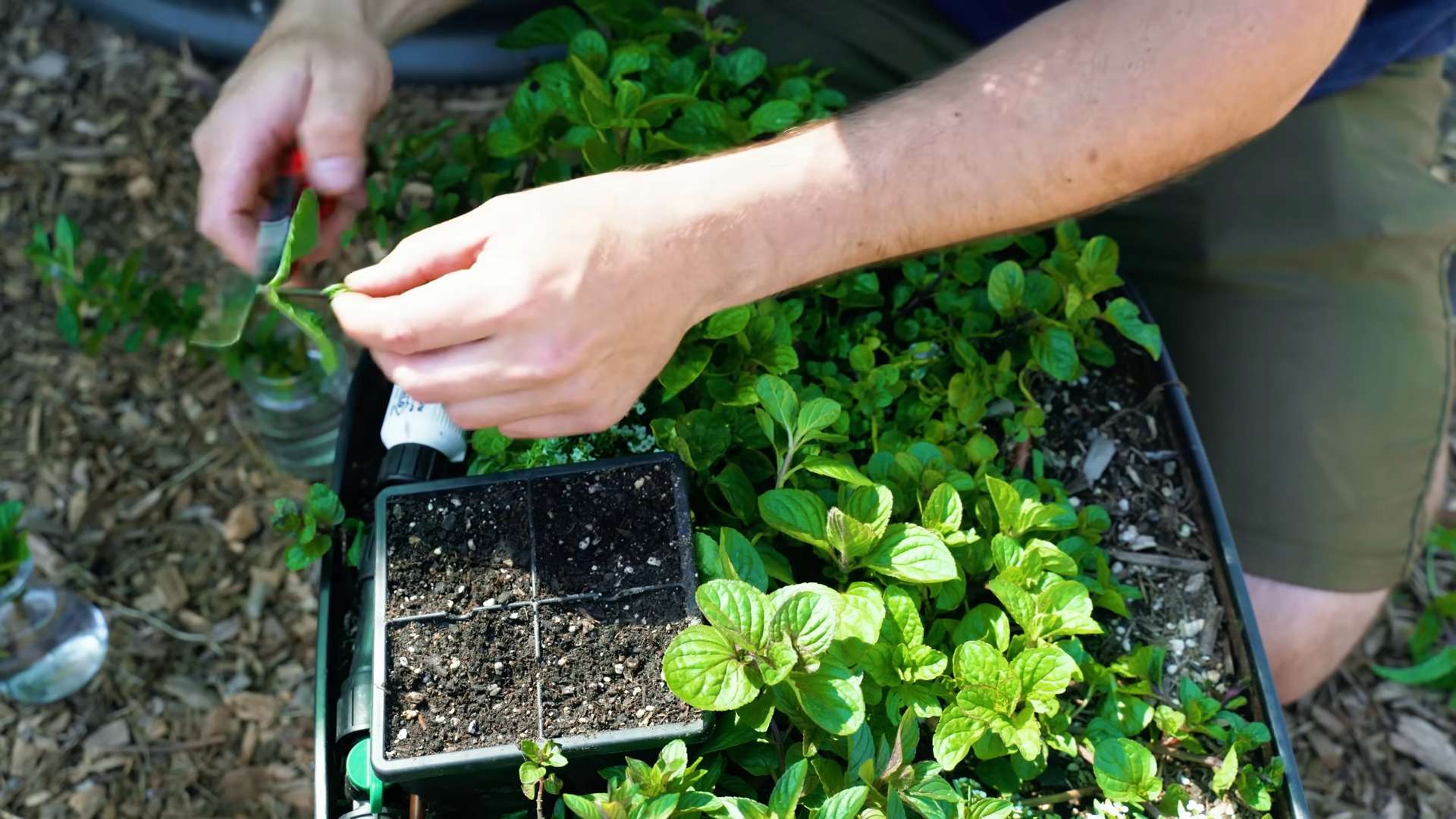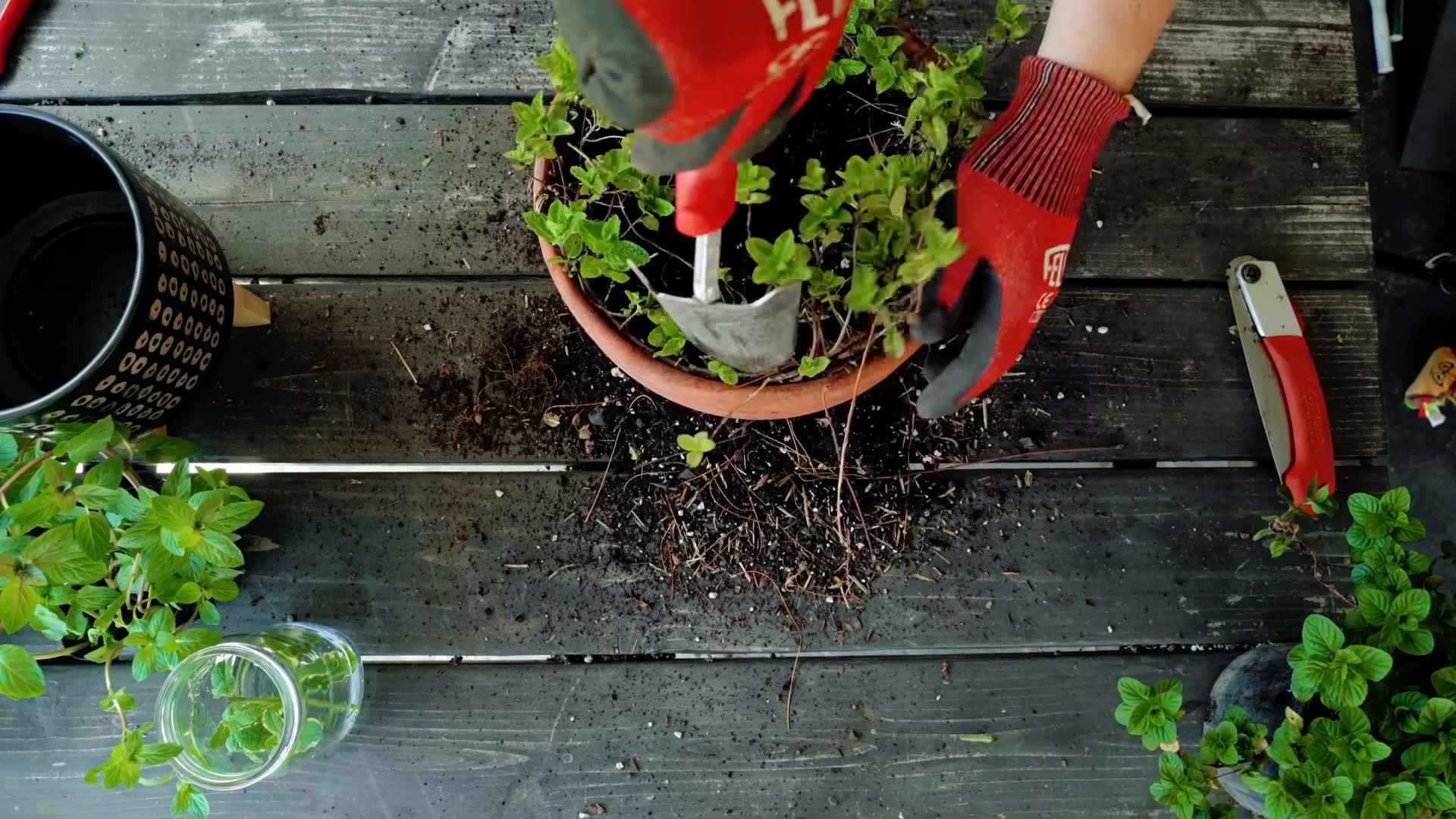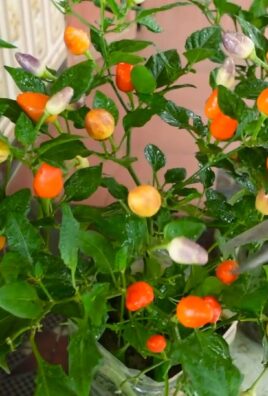Grow Mint Indoors? Absolutely! Imagine stepping into your kitchen and snipping fresh, fragrant mint leaves for your tea, mojito, or even a zesty salad dressing. No more last-minute grocery store runs or settling for wilted, sad-looking herbs. This isn’t just a dream; it’s an achievable reality with a few simple DIY tricks.
Mint, with its vibrant history stretching back to ancient Egypt and Rome, has always been prized for its medicinal and culinary uses. The Romans even believed that mint could sharpen the mind! While traditionally grown outdoors, bringing this versatile herb inside opens up a world of possibilities, regardless of your climate or garden size.
But why should you bother learning how to grow mint indoors? Well, for starters, it’s incredibly rewarding! Plus, mint is notorious for its invasive nature when planted directly in the ground – it can quickly take over your entire garden. Growing it in a container indoors keeps it contained and manageable. I’m going to show you some easy DIY hacks that will help you enjoy a thriving mint plant right on your windowsill, providing you with fresh, flavorful leaves year-round. Get ready to unleash your inner gardener!

Grow Your Own Mint Magic Indoors!
Hey there, fellow plant enthusiasts! Ever dreamt of having fresh, fragrant mint readily available for your mojitos, teas, or culinary creations? Well, dream no more! Growing mint indoors is surprisingly easy, and I’m here to guide you through every step of the process. Get ready to unleash your inner gardener and enjoy the refreshing goodness of homegrown mint, all year round!
Choosing Your Mint Variety
First things first, let’s talk about mint varieties. There’s a whole world of mint out there, each with its unique flavor and aroma. Here are a few popular choices for indoor growing:
- Peppermint: The classic choice, known for its strong, refreshing flavor. Perfect for teas and desserts.
- Spearmint: A milder, sweeter mint, ideal for mojitos and savory dishes.
- Chocolate Mint: A delightful blend of mint and chocolate flavors. Great for adding a unique twist to desserts and drinks.
- Apple Mint: A fruity, slightly sweet mint with a hint of apple. Delicious in salads and teas.
I personally love growing spearmint because it’s so versatile, but feel free to experiment and find your favorite!
Gathering Your Supplies
Before we dive into the planting process, let’s make sure you have everything you need. Here’s a checklist of essential supplies:
- Mint Seeds or Cuttings: You can start from seeds or, even easier, propagate from cuttings. I’ll explain both methods below.
- Pot: Choose a pot that’s at least 6 inches in diameter with drainage holes. Mint can spread quickly, so a slightly larger pot is a good idea.
- Potting Mix: Use a well-draining potting mix specifically formulated for containers. Avoid using garden soil, as it can become compacted and hinder drainage.
- Watering Can or Spray Bottle: For gentle watering.
- Grow Light (Optional): If you don’t have a sunny windowsill, a grow light can provide the necessary light for healthy growth.
- Scissors or Pruning Shears: For harvesting and trimming.
Starting from Seeds: A Patient Approach
Growing mint from seeds requires a bit more patience, but it’s a rewarding experience. Here’s how to do it:
Sowing the Seeds
1. Prepare the Pot: Fill your pot with potting mix, leaving about an inch of space at the top. Gently pat down the soil.
2. Sow the Seeds: Sprinkle the mint seeds evenly over the surface of the soil. Mint seeds are tiny, so don’t overcrowd them.
3. Cover the Seeds: Lightly cover the seeds with a thin layer of potting mix.
4. Water Gently: Use a spray bottle to mist the soil thoroughly. Avoid overwatering, as this can cause the seeds to rot.
5. Create a Humid Environment: Cover the pot with plastic wrap or a clear plastic bag to create a humid environment. This will help the seeds germinate.
6. Place in a Warm Location: Place the pot in a warm location with indirect sunlight.
7. Monitor Germination: Check the pot daily for signs of germination. Mint seeds typically germinate within 10-14 days.
8. Remove the Plastic Wrap: Once the seedlings emerge, remove the plastic wrap.
Caring for Seedlings
9. Provide Adequate Light: Place the seedlings in a sunny windowsill or under a grow light. They need at least 6 hours of light per day.
10. Water Regularly: Keep the soil consistently moist, but not soggy. Water when the top inch of soil feels dry to the touch.
11. Thin the Seedlings: Once the seedlings have developed a few sets of true leaves, thin them out, leaving the strongest seedlings spaced about 2-3 inches apart.
12. Fertilize Lightly: After a few weeks, start fertilizing the seedlings with a diluted liquid fertilizer every 2-3 weeks.
Propagating from Cuttings: A Quick Start
Propagating mint from cuttings is a faster and easier way to get started. Here’s how I do it:
Taking the Cuttings
1. Choose a Healthy Stem: Select a healthy, non-flowering stem from an existing mint plant. The stem should be about 4-6 inches long.
2. Make the Cut: Use clean scissors or pruning shears to cut the stem just below a leaf node (the point where a leaf grows from the stem).
3. Remove Lower Leaves: Remove the leaves from the bottom 1-2 inches of the stem. This will prevent them from rotting when submerged in water.
Rooting the Cuttings
4. Place in Water: Place the cuttings in a glass or jar filled with water. Make sure the bottom 1-2 inches of the stem are submerged.
5. Provide Indirect Light: Place the glass or jar in a location with bright, indirect light. Avoid direct sunlight, as this can overheat the water and damage the cuttings.
6. Change the Water Regularly: Change the water every 1-2 days to prevent the growth of bacteria.
7. Wait for Roots to Develop: Within a week or two, you should see roots starting to develop from the stem.
Planting the Rooted Cuttings
8. Prepare the Pot: Fill your pot with potting mix, leaving about an inch of space at the top. Gently pat down the soil.
9. Plant the Cuttings: Once the roots are about an inch long, carefully plant the cuttings in the pot.
10. Water Gently: Water the cuttings gently to settle the soil.
11. Provide Adequate Light: Place the pot in a sunny windowsill or under a grow light.
12. Keep the Soil Moist: Keep the soil consistently moist, but not soggy.
Caring for Your Indoor Mint Plant
Now that your mint plant is established, here’s how to keep it thriving:
Light
Mint loves sunlight! Aim for at least 6 hours of direct or indirect sunlight per day. If you don’t have a sunny windowsill, a grow light can be a great alternative.
Watering
Water your mint plant regularly, keeping the soil consistently moist but not soggy. Overwatering can lead to root rot, so make sure the pot has good drainage. I usually water when the top inch of soil feels dry to the touch.
Temperature
Mint prefers temperatures between 65°F and 75°F (18°C and 24°C). Avoid placing your plant near drafts or extreme temperatures.
Humidity
Mint appreciates humidity, especially during the dry winter months. You can increase humidity by misting the plant regularly, placing a tray of water near the plant, or using a humidifier.
Fertilizing
Fertilize your mint plant every 2-3 weeks with a diluted liquid fertilizer. This will provide the necessary nutrients for healthy growth.
Pruning and Harvesting
Pruning is essential for keeping your mint plant bushy and productive. Regularly pinch off the top leaves to encourage branching. You can also harvest larger amounts of mint by cutting stems back to just above a leaf node. Don’t be afraid to harvest generously – the more you harvest, the more your plant will grow!
Dealing with Pests and Diseases
Mint is generally pest-resistant, but it can occasionally be affected by aphids, spider mites, or whiteflies. If you notice any pests, try spraying the plant with insecticidal soap or neem oil. Overwatering can lead to fungal diseases, so make sure the pot has good drainage and avoid overwatering.
Repotting
Mint is a fast-growing plant, so you may need to repot it every year or two. Choose a pot that’s slightly larger than the current one and use fresh potting mix. Repotting will provide your plant with more space to grow and fresh nutrients.
Enjoying Your Homegrown Mint
The best part about growing your own mint is being able to enjoy its fresh, vibrant flavor. Here are a few ways to use your homegrown mint:
- Teas: Steep fresh mint leaves in hot water for a refreshing and soothing tea.
- Mojitos: Muddle mint leaves with lime juice, sugar, and rum for a classic mojito.
- Salads: Add chopped mint leaves to salads for a burst of flavor.
- Desserts: Use mint to garnish desserts or add it to ice cream, chocolate, or fruit salads.
- Savory Dishes: Mint can also be used in savory dishes, such as lamb, chicken, or vegetable curries.
I hope this guide has inspired you to grow your own mint indoors. It’s a rewarding and enjoyable experience

Conclusion
So, there you have it! Growing mint indoors is not only achievable, but it’s also incredibly rewarding. Imagine having fresh, fragrant mint leaves at your fingertips, ready to elevate your culinary creations, infuse your beverages, or simply add a touch of invigorating aroma to your home. This simple DIY project transforms your windowsill into a miniature herb garden, providing a constant supply of this versatile herb, regardless of the season.
Why is this a must-try? Because it’s economical, sustainable, and undeniably satisfying. Forget those wilted, overpriced bunches from the grocery store. With a little effort, you can cultivate your own thriving mint plant, ensuring a consistent supply of fresh, flavorful leaves. Plus, you’re reducing your environmental footprint by cutting down on packaging and transportation.
But the benefits extend beyond mere convenience and cost-effectiveness. Growing mint indoors is also a therapeutic activity. The simple act of tending to a plant, nurturing its growth, and witnessing its progress can be incredibly calming and grounding. It’s a small connection to nature in the midst of our busy lives.
Don’t be afraid to experiment with different varieties of mint. Peppermint, spearmint, chocolate mint – the possibilities are endless! Each variety offers a unique flavor profile, allowing you to tailor your indoor garden to your specific tastes and preferences. You can also try different containers, from simple terracotta pots to repurposed jars, adding a touch of personal style to your indoor garden. Consider using a self-watering planter to simplify the watering process, especially if you tend to forget.
Growing mint indoors is a game-changer for any home cook or herb enthusiast. It’s a simple, effective, and enjoyable way to bring the freshness of the garden into your home. We wholeheartedly encourage you to give this DIY trick a try. You’ll be amazed at how easy it is to cultivate your own thriving mint plant and enjoy the countless benefits it offers.
Once you’ve embarked on your indoor mint-growing journey, we’d love to hear about your experience! Share your tips, tricks, and successes in the comments below. Let us know which variety of mint you’re growing, what challenges you’ve encountered, and what delicious creations you’ve used your homegrown mint in. Your insights and experiences will not only inspire others but also help us all learn and grow together. So, grab a pot, some soil, and a mint cutting, and get ready to experience the joy of growing your own fresh mint indoors!
Frequently Asked Questions (FAQ)
1. What is the best type of mint to grow indoors?
The best type of mint to grow indoors depends on your personal preference. Spearmint and peppermint are popular choices due to their versatility and ease of growth. Chocolate mint and orange mint are also excellent options if you’re looking for something a little more unique. Consider the flavor profile you desire and choose a variety that suits your culinary needs. Remember that mint spreads aggressively, so keep different varieties in separate containers to prevent them from cross-pollinating and losing their distinct flavors.
2. What kind of soil is best for growing mint indoors?
Mint thrives in well-draining soil that is rich in organic matter. A good potting mix specifically formulated for herbs is ideal. You can also create your own mix by combining equal parts potting soil, perlite, and compost. The perlite will improve drainage, while the compost will provide essential nutrients. Avoid using garden soil, as it can be too heavy and may contain pests or diseases.
3. How much sunlight does indoor mint need?
Mint needs at least 4-6 hours of sunlight per day to thrive. A south-facing window is ideal, but an east- or west-facing window can also work. If you don’t have access to enough natural light, you can supplement with a grow light. Position the grow light a few inches above the plant and keep it on for 12-14 hours per day. Insufficient light can lead to leggy growth and reduced flavor.
4. How often should I water my indoor mint plant?
Water your mint plant when the top inch of soil feels dry to the touch. Avoid overwatering, as this can lead to root rot. Ensure that your pot has drainage holes to allow excess water to escape. During the warmer months, you may need to water more frequently than during the cooler months. Check the soil moisture regularly and adjust your watering schedule accordingly.
5. How do I harvest mint leaves from my indoor plant?
Harvest mint leaves by pinching or cutting off stems just above a leaf node. This will encourage the plant to branch out and produce more leaves. Avoid removing more than one-third of the plant at a time, as this can stress the plant. Regular harvesting will also help to keep the plant compact and prevent it from becoming leggy.
6. How do I prevent my indoor mint plant from becoming leggy?
Leggy growth is often caused by insufficient light. Ensure that your mint plant is receiving enough sunlight or supplement with a grow light. Pruning the plant regularly will also help to keep it compact and bushy. Pinch off the tips of the stems to encourage branching.
7. How do I deal with pests on my indoor mint plant?
Common pests that can affect indoor mint plants include aphids, spider mites, and whiteflies. Inspect your plant regularly for signs of infestation. If you notice any pests, you can try washing them off with a strong stream of water or using insecticidal soap. Avoid using harsh chemicals, as these can harm the plant.
8. Can I propagate mint from cuttings?
Yes, mint is very easy to propagate from cuttings. Simply take a 4-6 inch cutting from a healthy stem and remove the lower leaves. Place the cutting in a glass of water and wait for roots to develop. Once the roots are about an inch long, you can plant the cutting in a pot of soil.
9. My mint plant is flowering. Should I remove the flowers?
While mint flowers are attractive, they can reduce the flavor of the leaves. If you want to maximize the flavor of your mint, it’s best to remove the flowers as soon as they appear. Simply pinch off the flower buds or cut the stems back to a leaf node.
10. Is growing mint indoors year-round possible?
Yes, growing mint indoors year-round is definitely possible with proper care. Providing adequate light, water, and nutrients will ensure that your mint plant thrives even during the winter months. You may need to adjust your watering schedule and provide supplemental light during the shorter days of winter. With a little attention, you can enjoy fresh mint leaves all year long.




Leave a Comment